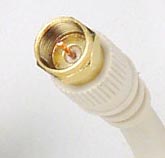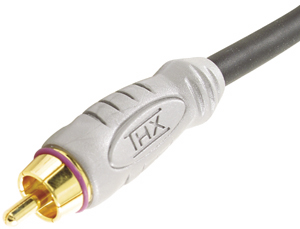Coaxial Cable
 Coaxial means that two things share a single axis. The
coaxial cable consists of three main parts: the inner conductor, the
outer conductor, and the surrounding insulation. The inner
conductor is usually a single wire that transmits the signals sent
along the coaxial cable. The outer conductor is made of a
different type of material and surrounds the inner conductor.
Often, it is composed of foil or braided, copper wires. The
surrounding insulation is the flexible material that is visible on the
outside of the coaxial cable. If this surrounding insulation
is thin enough, you can sometimes see the braiding of the outer
conductor protruding in the well worn areas.
Coaxial means that two things share a single axis. The
coaxial cable consists of three main parts: the inner conductor, the
outer conductor, and the surrounding insulation. The inner
conductor is usually a single wire that transmits the signals sent
along the coaxial cable. The outer conductor is made of a
different type of material and surrounds the inner conductor.
Often, it is composed of foil or braided, copper wires. The
surrounding insulation is the flexible material that is visible on the
outside of the coaxial cable. If this surrounding insulation
is thin enough, you can sometimes see the braiding of the outer
conductor protruding in the well worn areas.How Coaxial Cable Works
The way the coaxial cable works is simple. The signal that needs to be transmitted is sent along the inner conductor. The signal does not move in a straight line because the bends in the coaxial cable prevent this from happening. This is where the outer conductor comes into play. The outer conductor is composed of materials that work to reflex the signal off of the contact surface between it and the inner conductor. In this way, the signal is continually reflecting off of the outer conductor as it travels to its destination. Think of it like a racquetball bouncing off of the walls of a tube. And just like the racquetball, the signal loses energy as it travels the length of the coaxial cable. This loss of energy comes in the form of signal loss into the outer conductor. With each reflection off of the outer conductor, small amounts of signal are transmitted into it. This signal loss makes coaxial cable less than ideal for many applications, such as transmitting signals from your DVD player your television.RF and Digital
There are two main signals used for transmission over coaxial cable, radio frequency (RF) and digital. The RF coaxial cable is the type you are probably most familiar with; it is used for transmitting signals for cable television, television antennas, VCRs, etc. RF coaxial cable sends both video and audio all along the single wire of the inner conductor. The RF coaxial cable itself comes in two flavors, RG-59 and RG-6. RG-59 is the type used most often for the applications that were previously mentioned. Occasionally, when you buy a VCR it will include an RF coaxial cable so that you can use it right out of the box. More often than not, this is an RG-59 cable. RG-6 is a higher quality RF coaxial cable which employs better shielding to reduce signal loss.Digital coaxial cable employs an RCA connector rather than the screw type used for RF coaxial cable. This type of coaxial cable is designed specifically for transmitting digital audio
 signals
and nothing else. Since it is designed to send digital
information, the need to convert digital signals into another medium is
by-passed. This results in the elimination of audio artifacts
that can result from such signal conversion.
signals
and nothing else. Since it is designed to send digital
information, the need to convert digital signals into another medium is
by-passed. This results in the elimination of audio artifacts
that can result from such signal conversion.